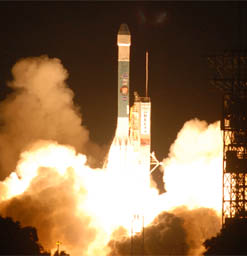December 3, 1999, was a dark day for planetary exploration. Mars Polar Lander, a novel attempt to dig into the ice-rich terrain surrounding the planet's south pole, disappeared without a trace as it tried to land, as did a pair of instrumented penetrators that had hitchhiked to Mars with MPL. I was keeping vigil with the project scientists, and the trauma of the loss was painfully obvious.
Even in those dark days, many on the team believed that if the polar mission was worth doing once, it would be worth doing again. They persevered, eventually getting the nod from NASA for a follow-on craft built in part with leftover MPL hardware. The new effort came to be called Phoenix, named for the mythical bird that consumed itself by fire, later to rise renewed from its own ashes. It's the first in a new spacecraft line known as Scout missions, highly innovative and relatively low-cost explorations of the Red Planet.

A Delta II rocket lifts off from Florida before dawn on August 4, 2007, carrying with it the Mars-bound Phoenix lander.
NASA / KSC
Fast-forward to 5:26 a.m. EDT on August 4, 2007: Riding a tower of flame from its Delta II rocket (launch pictures and video clip here), Phoenix raced upward into the predawn darkness over Cape Canaveral Air Force Station in Florida on the first leg of its journey to Mars.
This time the destination is the northern polar region, where, if the Great Galactic Ghoul doesn't strike again, Phoenix will arrive next May 25th. It's going to be an exciting mission, and I'm again hoping to be among the project scientists when it arrives.
 1
1
Comments
Steve Stanbery
August 5, 2007 at 12:16 pm
Kelly, your "Great Galctic Ghoul" is an excellent article that exposes additional surprising information on the failure of the Mars Observer and Mars Climate Orbiter missions. I highly recommend reading to those who haven't already.
You must be logged in to post a comment.
You must be logged in to post a comment.